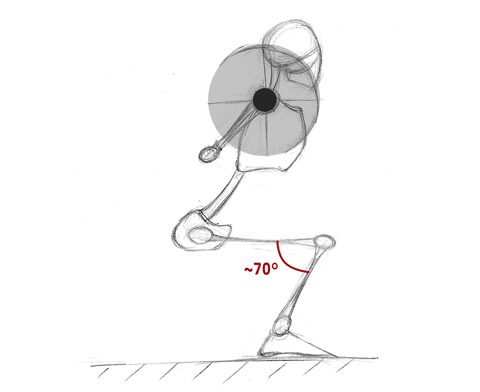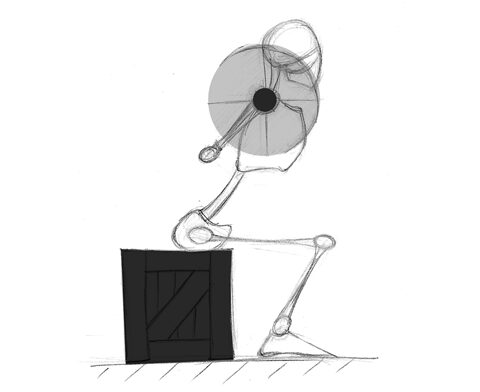Différences cinétiques et musculaires entre le squat et le box squat

Le squat est un exercice de musculation, et un des trois mouvements en Force Athlétique. Il s’exécute à partir de la position debout, il consiste en une flexion des membres inférieurs suivi d’une extension de ceux-ci. Selon les modalités de l’exercice, les besoins et les possibilités du pratiquant, le niveau de flexion, et donc l’angle cuisse – jambe, variera de 90 à 70 degrés, voire moins (Fig. 1). Le squat est fortement utilisé en préparation physique. En effet, il est un des exercices les plus étudiés et il montre un potentiel de transfert de la performance assez fort avec de nombreuses disciplines sportives (e.g., le sprint, le cyclisme). Nous reviendrons sur ce dernier point dans de futurs articles sur le site.
Lors de la flexion, le quadriceps (groupe musculaire située dans la loge antérieure de votre cuisse, extenseur de la cuisse sur la jambe) est étiré. Cet étirement va permette un stockage d’énergie potentielle élastique (pour une petite explication sur l’énergie potentielle élastique, voir ici). Or, le mouvement de squat enchaîne une flexion et une extension des membres inférieurs. La phase d’extension correspond, en partie, à la contraction des quadriceps. Lorsqu’un muscle se contracte immédiatemment après avoir été étiré, il subit un cycle étirement-détente. Cela signifie que l’énergie potentielle élastique stockée est restituée et participe au travail positif réalisé par le muscle lors de son raccourcissement. En termes moins techniques, un muscle qui se contracte immédiatement après avoir été étiré améliore sa performance de contraction. C’est le cas, par exemple, pour le saut vertical.
Tous ces points seront développées plus en détails dans un cours dédié à la mécanique musculaire qui sera en ligne prochainement.
L’étude réalisée
Une étude menée par une équipe de chercheurs américains de l’Appalachian State University s’est intéressée à l’influence du cycle étirement-détente en squat. Ces chercheurs se sont intéressés aux différences qu’il pourrait exister entre un squat et un box squat. Le box squat se déroule de la même façon qu’un squat traditionnel à l’exception que le pratiquant doit s’assoir sur une caisse (d’où son nom) pendant quelques secondes, et seulement après cette pause, il pourra effectuer la phase d’extension (Fig. 2). L’arrêt sur la caisse est censé inhiber le cycle étirement-détente.

Figure 1. Parallel Squat. 
Figure 2. IBox Squat.
Les tests ont été réalisés sur un échantillon de 8 hommes, tous compétiteurs en Force Athlétique avec un 1RM moyen en squat de 200,11 ± 58,91 kg. Les sujets ont réalisé des squats et des box squat avec 3 charges différentes qui correspondaient à 60, 70 et 80% de leur 1RM respectif. Tous les squats étaient réalisés avec un angle de genou égal à environ 70 degrés (Fig. 1).
Pour analyser les différences entre les deux mouvements, la force développée et la puissance produite ont été comparées. De plus, l’activité musculaire électrique de surface des muscles vaste latéral, vaste médial, biceps fémoral et longissimus a été enregistrée à l’aide d’électromyographie (EMG). Les différents systèmes et techniques de mesure seront développés prochainement dans le cours de Biomécanique du sport et de l’exercice.
Résultats & Analyses
Les chercheurs ont observé très peu de différences significatives entre les deux exercices au niveau de la force, de la puissance et de l’activité musculaire électrique de surface. Avec une charge équivalente à 70% de 1RM, la force maximale développée était plus importante lors du Box squat. Et à une charge équivalente à 80% de 1RM, la puissance produite était plus grande lors du box squat. Au niveau de l’EMG, l’activité du biceps fémoral était plus importante lors du squat à 60% du 1RM. Et à 70% du 1RM, l’activité du vaste latéral était plus importante lors du squat.
Ces résultats sont assez étonnants. D’un point de vue cinétique, les deux exercices semblent similaires. L’hypothèse était que le box squat montre des performances en force et en puissance plus faibles puisque le cycle-étirement détente n’était pas respecté avec la pause sur la caisse. Les chercheurs ont avancé deux hypothèses :
- Malgré la courte pause sur la caisse, la présence de la phase excentrique lors du box squat induirait néanmoins un cycle étirement-détente, et donc un bénéfice pour la phase de contraction.
- Lors du squat et du box squat, la phase d’amortissement avant d’atteindre le point le plus bas est assez longue, suffisament pour qu’aucun des deux exercices n’aie bénéficié efficacement du cycle étirement-détente.
- Il se peut également, que la phase de pause sur la caisse n’est pas été respectée. Le temps d’1 seconde impartie dans cette étude semble un peu juste.
Applications pratiques
Cette étude montre qu’il existe peu de différences au niveau de l’activité électrique musculaire entre les deux exercices. Bien que cette étude n’est pas montrée de différences cinétiques entre le squat et le box squat, le box squat peut être bénéfique sur plusieurs points :
- D’un point de vue sécuritaire, il est assez facile de régler la hauteur de la caisse sur laquelle le pratiquant viendra poser les fesses. Cet ajustement permettra donc de régler la profondeur du squat, et d’avoir un point de repère pour toujours descendre à la même profondeur.
- Grâce au réglage de la hauteur de la caisse, il est possible de dissiquer les différentes phases du squat, selon l’angle du genou, qui sont plus ou moins difficiles pour un athlète de force.
Le box squat apparait comme un exercice supplémentaire qui peut s’avérer utile pour un travail spécifique.
Références
McBride JM, Skinner JW, Schafer PC, Haines TL and Kirby TJ. Comparison of kinetic variables and muscle activity during a squat vs. a box squat. J Strength Cond Res 24 (12): 3195-3199, 2010.